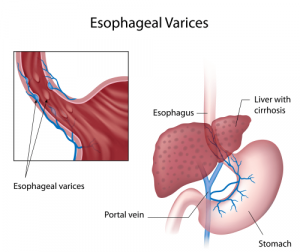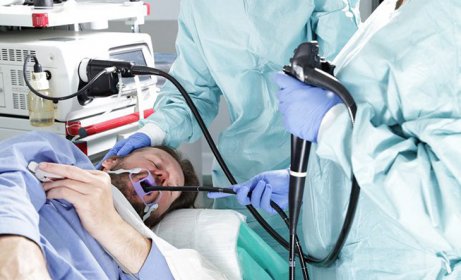Signs and symptoms of esophageal varices

We all know what varicose veins are dilated veins that cause venous insufficiency. However, there are also esophageal varices that are located at the end of the esophagus and hinder blood flow.
It’s important to talk to your doctor in case of any sign or symptom of esophageal varices. These are often confused with other less serious problems. Early treatment will help ensure that the condition doesn’t worsen.
How to know if you have esophageal varices

To find out whether or not you have esophageal varices, a study published in The Spanish Journal of Digestive Diseases exposes those factors that affect its appearance and the possible signs that should be taken into account in this pathology.
However, as the study indicated, many times esophageal varices are asymptomatic, and the symptoms that do manifest can be confused with other less serious conditions.
Let’s see what they are:
- Black stools: Although you may not think too much of this color, if it’s caused by this condition, it’s due to the presence of blood. This occurs when the veins rupture.
- Vomiting blood: At first, you may feel dizziness or lightheadedness, until you eventually vomit blood. If this happens to you, you need to go see your doctor immediately.
- Loss of consciousness: This usually happens due to the hemorrhage caused by esophageal varices, which leads to dizziness and fainting in severe cases
If these symptoms persist over time, you must go see a doctor as soon as possible. Losing consciousness, feeling dizzy, or vomiting blood can ring the alarm that you’re suffering from this risky condition.
This article may interest you: Symptoms of Inflammation of the Esophagus
Diagnosis: endoscopy
To make a reliable diagnosis, and after meeting with your doctor with the aforementioned symptoms, you will receive an endoscopy. This procedure also allows a doctor to take biopsies in order to provide an accurate diagnosis.
To do this, the doctor introduces a camera into the esophagus to see if there are abnormal veins. If they find any, this procedure also allows them to assess their severity. (That is, if they’re thick, if there are many of them, if there’s severe bleeding in the area, etc.)
Your doctor will opt for one treatment or another depending on the type of veins found. For example, if your doctor doesn’t find many, they’re small, and there’s no bleeding in the area, they may simply recommend a follow-up to see how they evolve.
Discover: How to Cure Wounds to Prevent Scars
Treatment Options

As we mentioned, one treatment or another will be chosen depending on the type of veins discovered through the endoscopy. Here are some of the treatment options that are available:
- Medication: If there’s no bleeding although the veins are large, drugs are administered to reduce their pressure.
- Endoscopic ligation: Doctors recommend this option when the patient can’t tolerate the drugs mentioned above. This procedure consists of strangling the veins with elastic bands to favor their disappearance.
- Endoscopic sclerotherapy: Doctors recommend it when there’s bleeding. It consists of injecting a substance into the veins.
All these treatments have possible complications. For example, drugs can cause unpleasant side effects such as nausea, diarrhea, or dizziness.
For this reason, the doctor will perform a thorough evaluation to discover what treatment will work best for the patient who’s suffering from esophageal varices.
What to do if you have symptoms?

People who suffer from cirrhosis (liver disease) or who’ve had thrombosis should be more careful with the symptoms or signs that may alert the presence of esophageal varices. Although esophageal varices may appear for other reasons, these are the most susceptible risk groups.
Finally, if you’re suffering from dark stools or dizziness or if you’re vomiting blood, you should go see a doctor as soon as possible. Early treatment will reduce your pain and discomfort and keep the situation from worsening.
If large esophageal varices rupture, it can lead to fairly severe bleeding that can endanger your life. Thus, you shouldn’t underestimate the signs that may be warning you of the presence of these abnormal veins.
All cited sources were thoroughly reviewed by our team to ensure their quality, reliability, currency, and validity. The bibliography of this article was considered reliable and of academic or scientific accuracy.
- Infante Velázquez, Mirtha, Rosado Vargas, Coralia, Pérez Lorenzo, Marlene, Samada Suárez, Marcia, & Hernández Amarán, Mariela. (2013). Factores predictivos de la presencia de várices esofágicas en pacientes cirróticos. Revista Cubana de Medicina Militar, 42(1), 56-61. Recuperado en 01 de febrero de 2019, de http://scielo.sld.cu/scielo.php?script=sci_arttext&pid=S0138-65572013000100008&lng=es&tlng=es.
- Vázquez González, Pedro, & Osorio Pagola, Marcos. (2010). Escleroterapia endoscópica de várices esofágicas. Presentación de un caso: nueva medida a tener en cuenta. MediSur, 8(5), 76-79. Recuperado en 01 de febrero de 2019, de http://scielo.sld.cu/scielo.php?script=sci_arttext&pid=S1727-897X2010000500014&lng=es&tlng=es.
- Velásquez Chamochumbi, Hermes. (2006). Hemorragia digestiva por várices esófago – gástricas. Acta Médica Peruana, 23(3), 156-161. Recuperado en 01 de febrero de 2019, de http://www.scielo.org.pe/scielo.php?script=sci_arttext&pid=S1728-59172006000300006&lng=es&tlng=es.
- Zumaeta Villena, Eduardo. (2007). Várices esofagogástricas. Acta Médica Peruana, 24(1), 47-52. Recuperado en 01 de febrero de 2019, de http://www.scielo.org.pe/scielo.php?script=sci_arttext&pid=S1728-59172007000100011&lng=es&tlng=es.
This text is provided for informational purposes only and does not replace consultation with a professional. If in doubt, consult your specialist.








